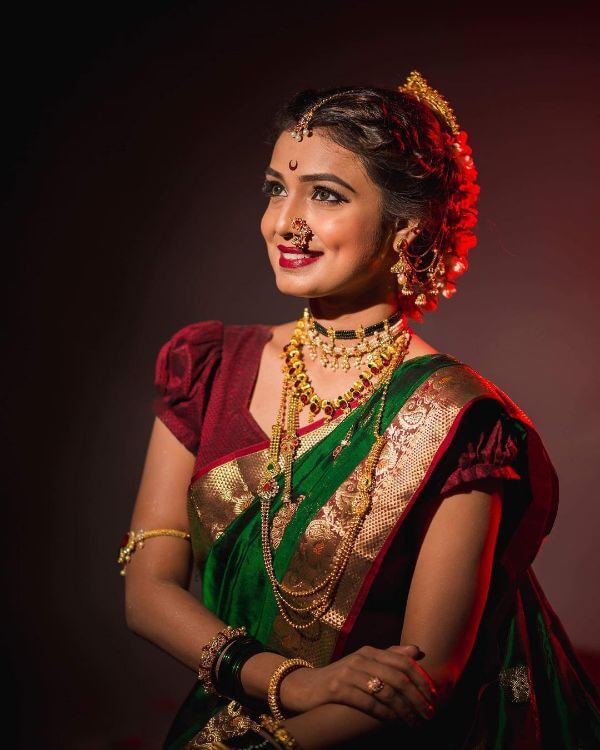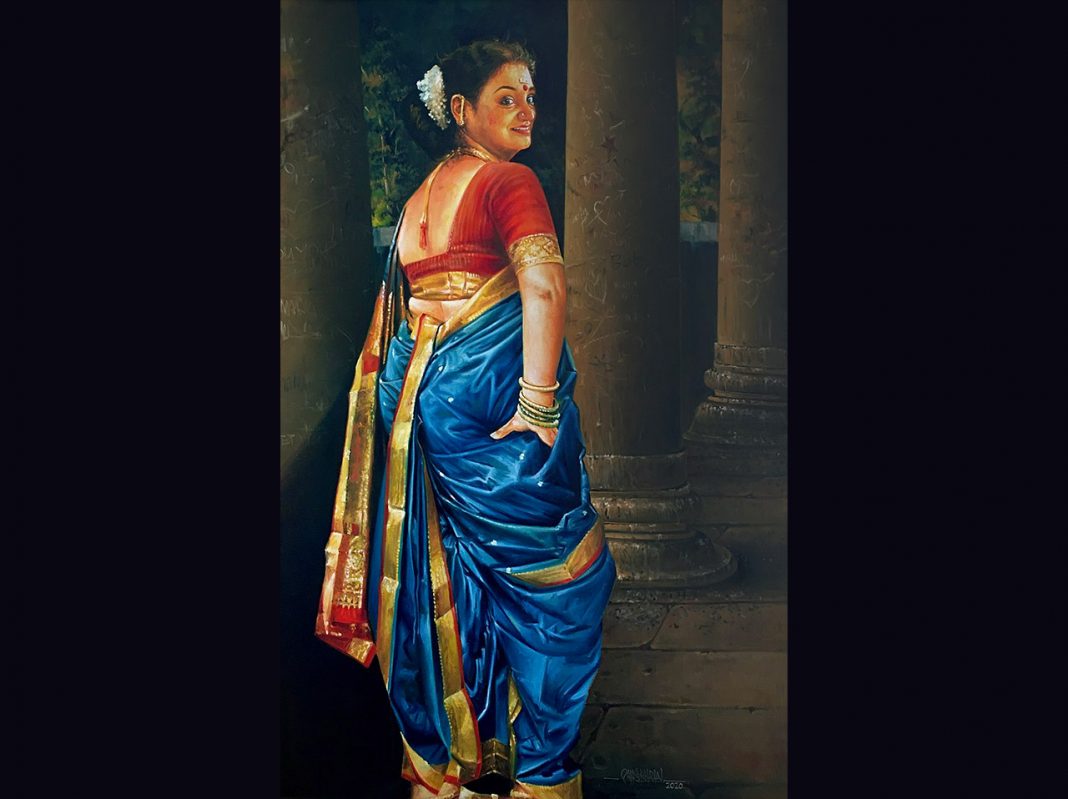
KRITI on Instagram “Vidarbha karvati kinar handloom tussar silk saree with running bp..
Karvati Silk Saree Background: In earlier days, handloom weavers of village Andhalgaon, Mohadi and Palandur District Bhandara, the part of Vidarbha region in Maharashtra used to produce cotton gamchha with 20s cotton yarn in warp and weft having two side Karvati border (Solid border). "Karvat" in Marathi is the saw and since the designs.

Tassar karvati plain saree single border Tribes India
The craft of "Tasar Karvati Saree" originated in the villages of Andhalgaon, Mohadi, and Palandur in the Bhandara district of Vidarbha, Maharashtra. In the past, handloom weavers in this region specialized in crafting cotton gamchha using 20s cotton yarn, featuring a distinctive two-sided Karvati border resembling a saw tooth.

Sarees That Maharashtrian Brides Can Pick Which Are Not Paithanis! in 2021 Indian
Karvati Silk - Weaves of Maharashtra - Save The Weave

Karvati woven tussar silk from Maharashtra. Silk dupatta, Saree styles, Sari blouse
Karvati silk saris hail from the Vidarbha region in the Bhandara district of Maharashtra. These saris are made from Tussar, a variety of silk with a grainy, textural feel. What is unique about the silk used in Karvati saris is that it is exclusive to this specific region that is rich in high-quality silk cocoons, straight from the wild.

Elegant Vidarbha Tussar Karvati Border saree Saree, Contrast blouse, Blouse piece
Karvati Saree is woven with desi tussar silk both in the warp and weft in the body portion, and 2/80 mercerized cotton is introduced for the border. The speciality of the Vidarbha Tussar Karvathi Saree is three-shuttle weaving (tapestry type of weaving). Item Type: Handloom Dimensions: 6.5mx1.2m Colour: Cream Material: Silk Occasion: Party State of Origin: Maharashtra

Most Beautiful Nauvari Sarees On Maharashtrian Brides (4) K4 Fashion
The Karvath Kati sarees a symbol of celebration and prosperity originates from the Vidharbha region of Maharashtra. Worn at auspicious rituals and at weddings they are also traditionally worn by the Vidharbha bride.. The uniqueness of the Tassar Karvati Sari is that, the border of the sari is woven with various temple design in different.

Anandi's Trunk on Instagram "Today's Pretty Palette! Lambani Embroidered Karvati Kinar Vidarbha
Tussar Karvati Plain Saree Catalogue 1. View Catalogues. Tussar Karvati Plain Saree Catalogue 2. View Catalogues. Tussar Karvati Printed Saree. View Catalogues. Featured Products of April Month.. MAHARASHTRA STATE HANDLOOMS CORPORATION LTD "MSHC Complex" Umrer Road Nagpur 440024 Mahārāshtra India. Email: [email protected] Phone: +91.

Elegant Vidarbha Tussar Karvati Kinaar (Border) saree Saree, Mercerized cotton yarn, Elegant
Karvat Kati Saree. The Karvat Kati Saree originated in the Vidarbha region of Maharashtra, in the 18th century CE. The name 'karvati kati' literally translates to "saw-edged", referring to the designs at the ends of the fabric that resemble the teeth of a saw. This saree is usually worn during rituals and ceremonies.

Fagun Handlooms Festive Wear Vidarbha Tussar karvati kinar plain saree, 6 m (with blouse piece
Karvati Kinar Vidarbha Tussar Handwoven Saree (Striped) Handwoven tussar by tussar silk saree with Ganga-Jamuna cotton borders from the weavers of the Vidarbha region of Maharashtra. This saree has traditional karvati (saw tooth) borders (kinaar) and a gorgeous running blouse piece and pallu. Please swipe left to see a

Elegant Vidarbha Tussar Karvati Kinaar saree with Ganga Jamuna border Mercerized cotton yarn
The saree is woven on pit loom mounted with Nagpuri wooden lattice dobby on the top of the loom above the weaver's seat. The uniqueness of the Tasar Karvati saree is that the border is woven with various temple designs in different sizes. The traditional motifs are woven with extra warp threads controlled by lattice dobby. How to distinguish. 1.

Printed Party wear Tussar Karvati Kinar Saree at Rs 2500 in Raigarh ID 14028169233
The Karvath Kati sarees a symbol of celebration and prosperity originates from the Vidharbha region of Maharashtra. Worn at auspicious rituals and at weddings they are also traditionally worn by the Vidharbha bride. This traditional saree is called Karvat Kati due to its unique saw-edged pattern on the border.

Sonali Kulkarni Saree styles, Traditional sarees, Marathi saree
Karvati Kinar Vidarbha Tussar Handwoven tussar by tussar silk saree with Ganga-Jamuna border from the Vidarbha region of Maharashtra. This saree has traditional karvati (saw tooth) borders (kinaar) and a running blouse piece.

Traditional Dresses of Maharashtra The Beauty of Intricacies
The Tasar Karvati Saree is woven with three shuttle weaving (tapestry type of weaving technique) to have solid colour border and body. The border is woven with mercerized cotton yarn and body is woven with pure tasar hand reeled yarn. The saree is woven on pit loom mounted with Nagpuri wooden lattice dobby on the top of the loom above the.

Vidarbha Tussar Silk Saree with Karvati Border SILK MARK CERTIFIED Shobitam saree Tussar
Discover the unique artistry of Karvati silk saris, exclusive to the Vidarbha region of Maharashtra. Made from Tussar silk with a saw-tooth border and mixed yarns, these saris are hand-loomed using a three-shuttle tapestry-style of weaving, resulting in a delicate yet sturdy piece. Learn how the craft was revived and how Karvati is expanding into trendy pieces like scarves and home furnishings.

Buy Mau Silk Shahi Mastani Nauvari Saree at Best Price Nauvari saree, Traditional indian
Vidarbha. Karvati (saw tooth) Kinaar (border) sarees are handwoven using the three-shuttle technique in the weaving cluster of Vidarbha, Bhandara district of Maharashtra. The abundantly rich forests of the Vidarbha region, in the eastern-most part of Maharashtra, produce naturally-found silkworms, that feed off bushes and trees.

Vidarbha Tussar SAREE with Karvati Border Karvati Kinaar Saree Sarees for Women Authentic
Brief Description. Cotton and silks woven in India were one of the principal trade items until the 20th century CE, with brocades, fine cotton and linen being exported along with spices and other items. The Paithani, originating from Paithan is one such handloom treasure purely woven in silk and Zari. Evolution.